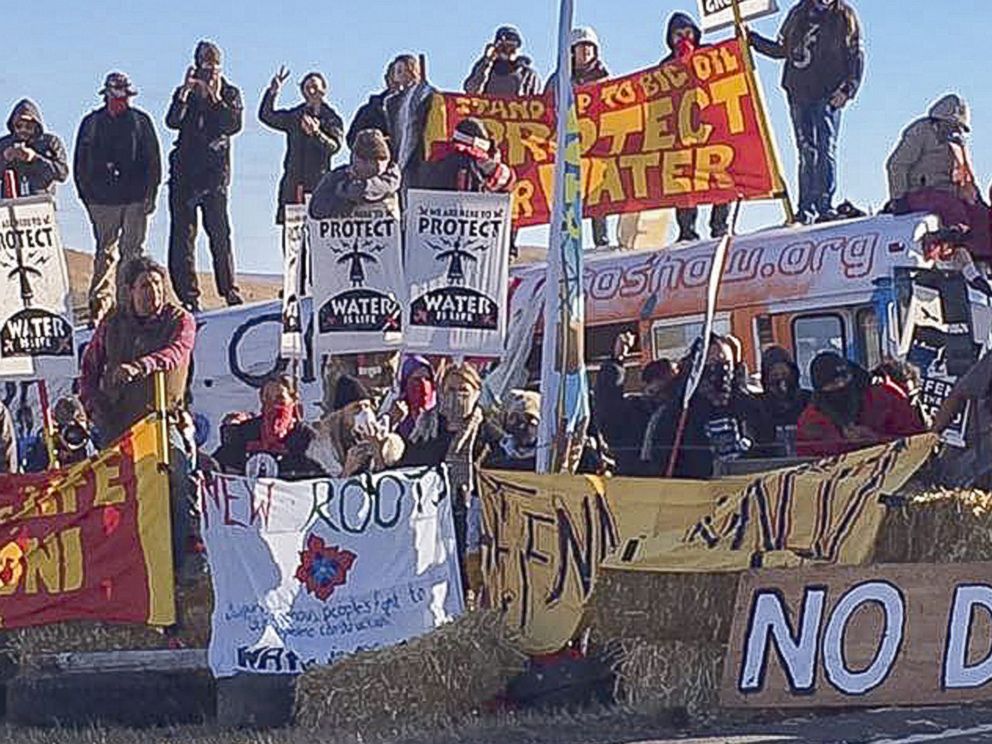Oregon Siege and North Dakota Protest: Both Land Battles, But Similarities End There
In both cases, demonstrators were exercising their First Amendment rights.
— -- On the same evening that police clashed with fervent protesters of a controversial oil pipeline in North Dakota, the ringleaders of another high-profile standoff in Oregon were acquitted of illegally occupying a federally-owned wildlife refuge.
In both cases Thursday night, demonstrators had been taking a stand and exercising their First Amendment rights over what they perceived to be an injustice that threatened their land rights, but that is about as far as the similarities go.
Here is how the developments concerning the two protests played out:
What They Were Protesting
In North Dakota, the Standing Rock Sioux Tribe, environmental activists and various Native American groups have been protesting for months the four-state Dakota Access Pipeline, a crude oil pipeline which they say traverses culturally sacred sites and could contaminate the area's water supply.
The tribe has sued to block construction of the pipeline in the courts, but a federal judge and a subsequent appeals court denied the tribe's requests for an injunction to halt construction near its reservation. Tribal leaders have argued that they were never meaningfully consulted before permits were granted to the pipeline company. The pipeline company argued in court documents, however, that they followed a standard review process.
Thousands of people have camped out on the reservation and nearby federally-owned land to protest, including private property owned by Dakota Access, a subsidiary of Energy Transfer Partners, that will build the pipeline. Energy Transfer CEO Kelcy Warren wrote that "concerns about the pipeline’s impact on the local water supply are unfounded," and that "multiple archaeological studies conducted with state historic preservation offices found no sacred items along the route."
Meanwhile, more than 1,000 miles away in Oregon, an armed group of mostly white protesters led by Ammon Bundy took a stand earlier this year against the federal use of land by taking over a federally-owned bird sanctuary, the Malheur National Wildlife Refuge, in the rural, eastern part of the state. The protesters objected to the prison sentences given to Dwight and Steven Hammond, two ranchers who had been convicted of arson.
The Oregon protesters wanted the government to free the two ranchers and release publicly-owned land to local officials, according to The Associated Press. The protesters began their initial occupation on Jan. 2. At the time, ABC News referred to the protesters as "a group of militia members."
Bundy said the group's goal was to help local workers, including ranchers, miners and hunters, benefit from the land. The group wanted to assert that the federal government does not have the right to own or control land inside the state, according to Bundy.
Protesting Tactics
Protesters in North Dakota have been for the most part unarmed, and any acts of violence have been condemned by tribal leaders.
"We call on the thousands of water protectors who stand in solidarity with us against DAPL to remain in peace and prayer. Any act of violence hurts our cause and is not welcome here," according to a statement released yesterday by Dave Archambault II, the chairman of the Standing Rock Sioux Tribe.
Joye Braun, 47, who has been protesting the pipeline since April, told ABC News earlier this week that "we are completely unarmed, we have been praying, we have been singing, we have been dancing."
The Morton County Sheriff's Department in North Dakota did report that one woman, of the hundreds of protesters, was armed and fired three rounds at police officers. She was subsequently arrested last night.
Meanwhile, more than 30 guns were seized from the Oregon protesters following their standoff last winter, and an FBI agent testified that 16,636 live rounds and nearly 1,700 spent casings were found in their hideout, according to the AP.

Law Enforcement Response
Law enforcement officials have taken markedly different approaches to the protesters.
In Oregon, a few days after the armed takeover of the federal land, Harney County Sheriff David Ward told local newspaper The Oregonian: “We're not amassing some army because we're looking for a fight." ABC News reported at the time of the standoff that the federal government was taking a "low key" approach to dealing with the militia group. Eventually a lengthy negotiations process was set up by authorities, but protesters stayed in control of the federal land for nearly 40 days.
The Malheur National Wildlife Refuge's manager told employees to stay home rather than confront armed strangers, according to the AP.
Most of the protesters in Oregon were eventually arrested on Jan. 26 during a police standoffduring which protester Robert "LaVoy" Finicum was killed. A few demonstrators remained until Feb. 11; all eventually surrendered. Late yesterday, a jury acquitted all seven defendants involved in the armed standoff of federal conspiracy and firearms possession charges.
In North Dakota, the Morton County Sheriff's Department public information officer said they were not disclosing the number of law enforcement officials they had assembled, but photos and video from the scene depict dozens of heavily armed officers clad in riot gear. The public information officer said they were using SWAT trucks and a LRAD, a long range acoustic device (often colloquially referred to as a sound cannon), used to disperse crowds by emitting a painful, high-pitched frequency sound.
Police also reportedly used tear gas on protesters and arrested 141 protesters on Thursday night, bringing the total number of arrests since mid-August up to 410 people, according to the Morton County Sheriff's Department. Police unleashed pepper spray and beanbags on protesters yesterday, according to the AP.





